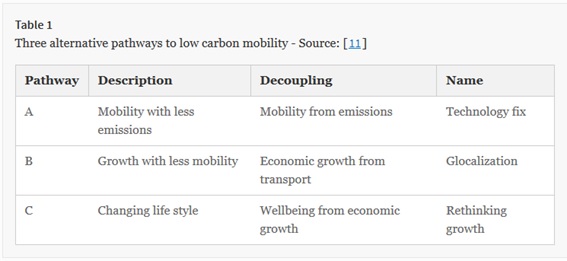A future of Low Carbon Mobility?
This is a summary of the article ” The autonomous car—a blessing or a curse for the future of low carbon mobility? An exploration of likely vs. desirable outcomes”, by Nikolas Thomopoulos and Moshe Givoni, – European Journal of Future Research , December 2015, 3-14.
The Low Carbon challenge: the ‘autonomous car’ ignites the imagination, yet the research and debate on this topic largely focus on the ‘autonomous’ and not adequately on the ‘car’ element. Like any new technological development, autonomous transport presents ample opportunities to better our mobility system, but similarly it carries risks and can lead into a future mobility that exacerbates, rather than relieves, current deficiencies of our mobility systems, including its high carbon and high cost characteristics. Researchers Thomopoulos, from The LSE Cities, London School of Economics and Political Science, and Givoni, from the Transport Research Unit, Department of Geography and the Human Environment, Ten Aviv University, have explored where there is a gap between the likely and desirable outcomes when developing the autonomous car and suggested how it could be reduced.
Moving towards low carbon mobility
Our mobility can be described as high-carbon, where carbon serves as a proxy to a wide range of environmental impacts associated with the way we travel and other negative conditions such as obesity and sedentary lifestyle inherited by our reliance and use of the private car. Low carbon mobility, on the other hand, is defined as mobility that results in substantially lower levels of carbon emissions and can be considered as the ultimate goal for transport policy, planning as well as research. Hardly anyone will argue against the need to move towards low carbon mobility, but there is hardly any agreement on the optimal way to achieve it. Givoni suggesteds three generic pathways to reach low carbon mobility:
Currently the Autonomous Vehicle (AV), and most of the research surrounding it, is probably the most outstanding example of Pathway A, where all efforts are focused on technological developments to decouple mobility from emission of Green House Gases (GHG) and air pollutants. In Pathway B, low carbon mobility is achieved by decoupling economic growth from the demand for transport—largely by focusing on localization and on reducing distances travelled (the global element of society will remain—hence glocalization). Since accessibility may be increased either by increasing velocity (i.e., quicker access to destinations) or proximity (i.e., closer location of destination), it is obvious that corresponding decisions can lead to different outcomes. In the US for example it has been found that solely by doubling urban density within metropolitan regions, vehicle kilometres travelled (VKT) can be reduced by up to 25 % if employment locations are also concentrated spatially. Therefore, a new lifestyle approach is advocated in Pathway C, which questions the merit of constantly pursuing economic growth. Focusing instead on improving well-being, which means decoupling wellbeing from economic growth, can act as the means to secure low carbon mobility.

The Low Carbon Mobility (LCM) framework corresponds well with the automobile dependence and ‘peak car’ arguments, which promote a paradigm change in transport planning. The ‘peak car’ theory suggests that “trends in car ownership and use in developed economies […] have passed a turning point and are now in long term decline”. Urbanization and socio-demographics will play a key role in the future determining car use as showcased in developed cities which have reached that level, for example London. Focusing on developed countries with available data, only Finland, Israel and The Netherlands experienced small increases (<1 % annually) in the driving license registrations of young people, whereas all other developed countries experienced decreases. Ageing and the role of young adults at an age eligible to acquire a driving license are key factors influencing synchronous trends in France, Germany, the US and the UK, and will continue to do so in the future. Despite it being unclear why the ‘peak car’ phenomenon is observed in developed countries whilst developing countries are projected to increase their car ownership levels, it is certainly clear that AVs have the potential to revert such trends and reintroduce car use for all age groups irrespectively on whether they own a license or not. How the latter trend is managed in the future could alter car traffic forecasts currently based on the ‘predict and provide’ model and have a substantial impact on car use. In trying to explain ‘peak car’, attention seems to focus on lifestyle and attitudinal factors, and this is likely to be critical in aligning the likely and the desirable outcomes of the development of the AV.
Future Scenarios: car sharing, AV, and Low Carbon Mobility
Various scenarios are possible for the future. The ‘peak car’ phenomenon presents a unique opportunity to shape and influence not only future mobility levels (how much we travel) but also how we travel. Hence it can be said with high certainty that AVs will have a decisive effect on future mobility. Other researchers are saying that: “We must bring together technology, systems design methods and business models to supply better mobility at low cost to consumers and to societies”. This is an attractive proposition with which it is almost impossible to disagree. But it is the exact same thinking that brought the mobility benefits of the ‘with-driver’ private car and the high-carbon mobility with it, the one we now try so hard to move away from. If it is hard to get people out of their cars it can be expected to be harder to get people out of their autonomous cars given the higher number of available options to use travel time for work or leisure. Travel time will then be seen as useful time, namely not wasted time decreasing travel utility. If we will choose to go down the road we now try so hard to escape, the AVs will with high certainty be a curse.
At the same time and as noted previously, AVs offer a unique opportunity to de-privatise car use through sharing. This could have a transformative impact on our mobility. Even more so if sharing will be in the form of more than one individual or groups using the car interchangeably (sharing can take place temporally and spatially). Using AVs to boost car sharing has the potential to reduce environmental impacts. Yet, this is often taken as given not considering at all any unintended consequences, especially overlooking the potentially large rebound effect stemming from overcoming the reality of wasting time while in the car (or, put in other words, the potential to use time more productively while in the car) especially when trying to find a parking space. Given that transport is the sector with the highest growth in terms of energy use and that 96 % of all transport uses fossil fuel, fuel resources and green transport are intertwined. Other researchers describe a continuum that runs from car owning on one hand, through car and bike sharing, to public transport on the other—the ultimate and full sharing mobility service. The AV opens up the opportunity for new ‘green’ autonomous public transport.
Please, read the full article at: https://link.springer.com/article/10.1007/s40309-015-0071-z


















